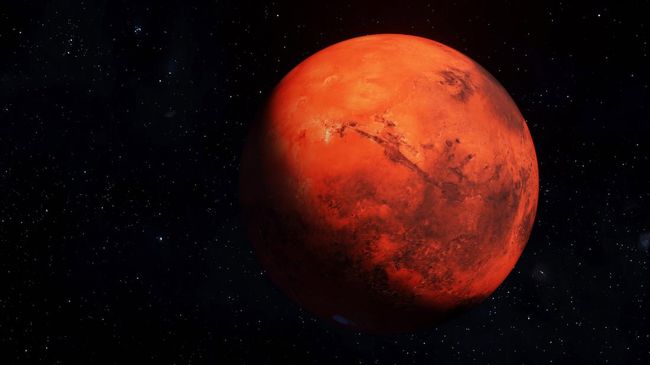CNN Indonesia
Friday, 08 Sep 2023 09:54 IWST
Illustration. Scientists from Germany claim that NASA killed aliens on the planet Mars 50 years ago. (Photo: iStockphoto/Cobalt88)
Jakarta, CNN Indonesia —
Moment of existence alien is still controversial, one scientist claims that the United States Aeronautics and Space Administration (NASA) once killed extraterrestrials on Planet Mars almost 50 years ago.
Astrobiologist from the Technical University of Berlin Dirk Schulze-Makuch claims NASA has discovered aliens, or extraterrestrial life forms, on Mars, and accidentally killed them.
After landing on the Red Planet in 1976, NASA’s Viking space probe likely sampled life forms hiding in Martian rocks.
If these extreme life forms existed and continue to exist, wrote Schulze-Makuch in his article in Big Thinkexperiments conducted by the landers may have killed them before they were identified, as the testing would have “overwhelmed these potential microbes.”
However, other experts differ on whether the new claim is just a far-fetched fantasy or an interesting explanation for some puzzling past experiments.
Sculze-Makuch acknowledged that his theory is “a conjecture that some may find provocative.” But similar microbes live on Earth and could hypothetically live on the Red Planet, so they cannot be ignored, quote Live ScienceThursday (7/9).
Viking Experiments
Each of the Viking spacecraft, namely Viking 1 and Viking 2, carried out four experiments on Mars, namely the gas chromatography mass spectrometer (GCMS) experiment which looked for organic compounds or those containing carbon, in the Martian soil.
Then, labeled molecule release experiments, which test metabolism by adding radioactively traced nutrients to the soil.
There are also pyrolytic release experiments (the decomposition of chemical compounds at high temperatures), which test carbon fixation by potential photosynthetic organisms.
Finally, a gas exchange experiment, which tests metabolism by monitoring how gases known to be key to life (such as oxygen, carbon dioxide and nitrogen) change around an isolated soil sample.
The results of the Viking experiments have puzzled many scientists since then. Labeled discharge and pyrolytic discharge experiments produced several results supporting the idea of life on Mars.
That, in the two experiments, small changes in the concentrations of some gases suggests some kind of metabolism is taking place.
Obtained from Big ThinkGCMS also found some traces of chlorinated organic compounds, but at the time, mission scientists believed these compounds were contamination from cleaning products used on Earth.
However, the gas exchange experiment, considered the most important of the four, gave negative results, leading most scientists to ultimately conclude that Viking had not detected life on Mars.
However, Schulze-Makuch believes most of these experiments may have produced inconsistent results because they used too much water.
“Because Earth is a water planet, it makes sense that the addition of water could cause life to emerge in the extremely dry environment of Mars,” writes Schulze-Makuch, “In hindsight, perhaps that was too good an approach.”
In a 2018 study published in the journal Scientific Reports, researchers revealed that too much water can kill small organisms.
This was proven in extreme flooding in the Atacama Desert which killed up to 85 percent of native microbes that could not adapt to wet conditions.
Schulze-Makuch writes adding water to every potential microbe in a Viking soil sample may have been the equivalent of stranding humans in the middle of the ocean: both needed water to survive, but if the concentration was wrong, it could have been deadly for them.
Alberto Fairén, an astrobiologist at Cornell University and one of the authors of the 2018 study, said he “strongly agrees” that adding water to the Viking experiment could have killed potential hygroscopic microbes and led to contradictory results from Viking.
NASA scientists said
Other experts believe that the results of the Viking study are “less ambiguous” than those proposed by Schulze-Makuch et al.
In 2007, NASA’s Phoenix lander, the successor to the Viking lander, found traces of perchlorate – a chemical used in fireworks, road flares and explosives, and naturally found in some rocks – on the planet Mars.
The general scientific consensus is that the presence of perchlorate and its byproducts can adequately explain the gas detected in Viking’s initial research results.
Chris McKay, an astrobiologist at NASA’s Ames Research Center in California, called the evidence essentially “resolving the Viking dilemma.”
He also said that scientists who continue to underestimate the results of the Vikings are wasting their efforts.
“I don’t agree with their logic,” he said. “There is no need to invoke a strange new type of life to explain the results of the Vikings.”
(can/dmi)
2023-09-08 02:54:00
#Expert #Claims #NASA #Killed #Aliens #Mars #Years


